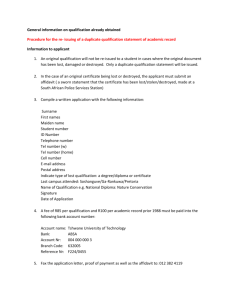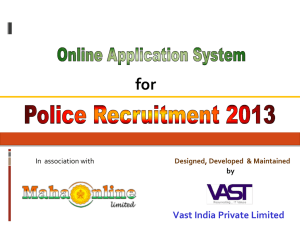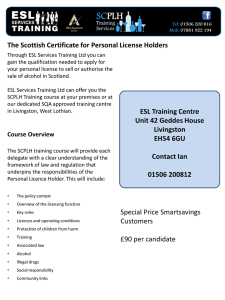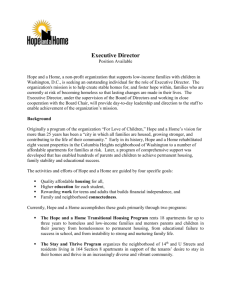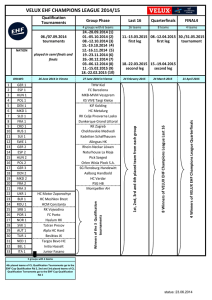Microsoft Word
advertisement
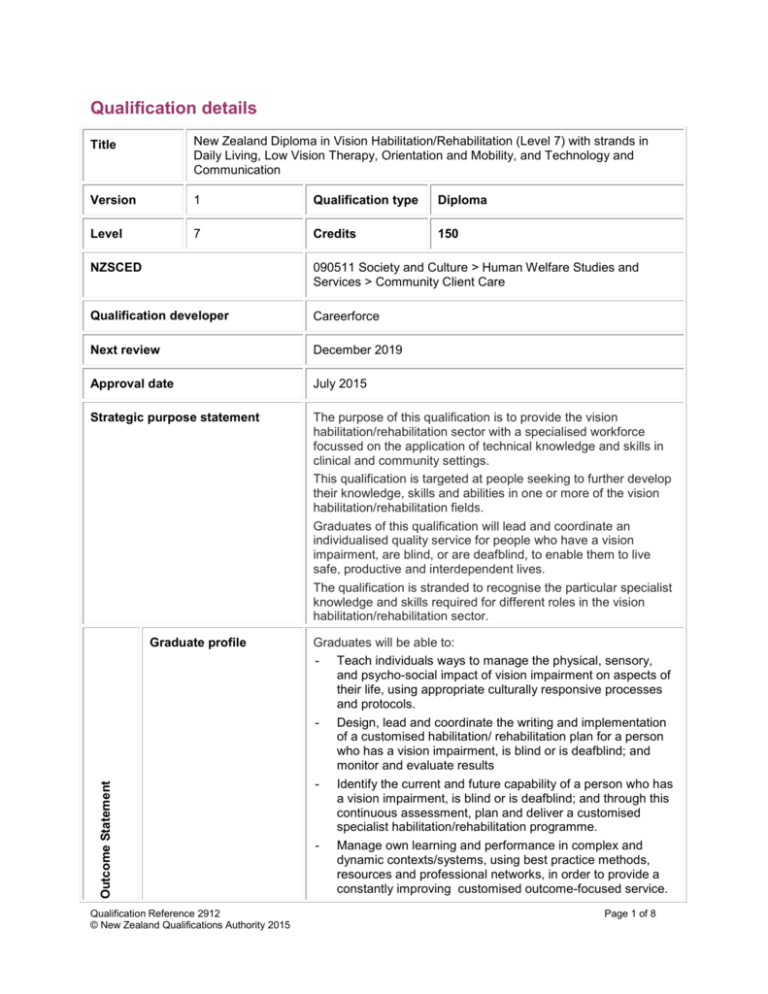
Qualification details Title New Zealand Diploma in Vision Habilitation/Rehabilitation (Level 7) with strands in Daily Living, Low Vision Therapy, Orientation and Mobility, and Technology and Communication Version 1 Qualification type Diploma Level 7 Credits 150 NZSCED 090511 Society and Culture > Human Welfare Studies and Services > Community Client Care Qualification developer Careerforce Next review December 2019 Approval date July 2015 Strategic purpose statement The purpose of this qualification is to provide the vision habilitation/rehabilitation sector with a specialised workforce focussed on the application of technical knowledge and skills in clinical and community settings. This qualification is targeted at people seeking to further develop their knowledge, skills and abilities in one or more of the vision habilitation/rehabilitation fields. Graduates of this qualification will lead and coordinate an individualised quality service for people who have a vision impairment, are blind, or are deafblind, to enable them to live safe, productive and interdependent lives. The qualification is stranded to recognise the particular specialist knowledge and skills required for different roles in the vision habilitation/rehabilitation sector. Outcome Statement Graduate profile Qualification Reference 2912 © New Zealand Qualifications Authority 2015 Graduates will be able to: - Teach individuals ways to manage the physical, sensory, and psycho-social impact of vision impairment on aspects of their life, using appropriate culturally responsive processes and protocols. - Design, lead and coordinate the writing and implementation of a customised habilitation/ rehabilitation plan for a person who has a vision impairment, is blind or is deafblind; and monitor and evaluate results - Identify the current and future capability of a person who has a vision impairment, is blind or is deafblind; and through this continuous assessment, plan and deliver a customised specialist habilitation/rehabilitation programme. - Manage own learning and performance in complex and dynamic contexts/systems, using best practice methods, resources and professional networks, in order to provide a constantly improving customised outcome-focused service. Page 1 of 8 Graduates of the Daily Living strand also will be able to: - Provide an adaptive/developmental daily living service to enable people who have a vision impairment, are blind, or are deafblind, to reach their potential through the use of compensatory skills to perform everyday activities. Graduates of the Low Vision Therapy strand will also be able to: - Provide a low vision person-centred therapy service to enable people who have low vision to maximize their visual skills and abilities. Graduates of the Orientation and Mobility strand will also be able to: - Provide an orientation and mobility service to teach people who have a vision impairment, are blind, or are deafblind, to use their remaining senses to determine their position in space and to plan and negotiate safe and efficient travel. Graduates of the Technology and Communication strand will also be able to: - Provide an adaptive/developmental technology and communication service to enable people who have a vision impairment, are blind, or are deafblind to communicate, and to access and manage information. Education pathway The qualification provides a pathway for people with a disabilityfocussed qualification at level 4, 5, or 6 to progress within the health and disability qualifications framework; and for people already holding other higher level qualifications in a Human Service related field, seeking to focus on one of the vision rehabilitation/habilitation specialisations. Graduates may progress via an appropriate undergraduate degree (i.e., Bachelor of Health Science with a major in Rehabilitation) to a specialised educational or clinical qualification such as the Postgraduate Diploma in Rehabilitation or Master of Health Science (Rehabilitation); or complete another specialisation in vision rehabilitation by undertaking training in an additional strand of this diploma. Employment pathway Graduates may obtain employment as: - Activities of Daily Living (ADL) Instructors - Orientation and Mobility (O&M) Instructors - Independent Living Skills Specialists (ADL & O&M) - Rehabilitation Instructors (ADL & O&M) - Vision Rehabilitation Needs Assessors (with ADL responsibilities) - Accessible Information Consultants - Employment Consultants - Vision Therapists - Deafblind Coordinators (with ADL responsibilities) - Pacific Services Coordinators (with ADL responsibilities) - Adaptive Technology Consultants or Trainers - Accessible Formats Producers Qualification Reference 2912 © New Zealand Qualifications Authority 2015 Page 2 of 8 - Braille Producers Braille Proofreaders Braille Awareness Consultants Equipment Solutions Salespersons This qualification may also be suitable, as an added specialty for people working in the following occupations: - Counselling - Diversional Therapy - Employment support - Occupational Therapy - Physiotherapy - Rehabilitation Therapy - Needs Assessment and Service Coordination - Nursing - Social Work - Teaching - Vision Hearing Screening - Sport and Recreation - Guide Dog Instruction Qualification specifications Qualification award This qualification will be awarded by Careerforce as the qualification developer and the industry training organisation arranging training leading to the qualification under section 5 of the Industry Training Act 1992. This qualification may also be awarded by a tertiary education organisation (TEO) accredited under section 250 of the Education Act 1989 to deliver an approved programme leading to this qualification. The certificate will display the title of the qualification, including the strand(s) achieved, the logo of NZQA, and the name and/or logo of the awarding organisation. Evidence requirements for assuring consistency All TEOs either arranging training or delivering programmes that lead to the award of this qualification are required to participate, along with the qualification developer, in a scheduled consistency process led by NZQA, in accordance with published national guidelines. This consistency process will involve reviewing evidence associated with graduates’ achievement of outcomes, establishing a periodic cycle for a review focus for the external consistency review, agreeing acceptable standards and/or benchmarks for qualification outcome achievement, and identifying areas for improvement. Evidence may include: • Assessment information leading to the achievement of the graduate outcomes. • A portfolio of student work relating to the qualification. Qualification Reference 2912 © New Zealand Qualifications Authority 2015 Page 3 of 8 • • • • Stakeholder feedback on outcome achievement which may include feedback from graduates, end-users and/or next users. TEO moderation outcomes which may include moderation/benchmarking across common programmes. Relevant External Evaluation and Review (EER) data. Evidence of compliance with the criteria of Consent and Moderation Requirements document 0024 for unit standardbased programmes. Minimum standard of achievement and standards for grade endorsements Achievement of all common outcomes and the outcomes of at least one strand. There are no grade endorsements for this qualification Other requirements for the qualification (including regulatory body or legislative requirements) It is recommended that people undertaking this qualification should hold a relevant tertiary qualification and/or have relevant core skills, knowledge and experience that apply to the health and disability workforce. General conditions for the programme leading to the qualification General conditions for programme Qualification Reference 2912 © New Zealand Qualifications Authority 2015 There is an expectation that industry training programmes leading to this qualification will be completed in a workplace. For programmes of study that are offered by an education provider, a formal arrangement must be in place whereby a learner is able to demonstrate achievement of the outcomes in an appropriate practical environment. For all programmes the practical learning must be developed and applied through work-placements under the supervision of a relevant qualified specialist. The achievement of practical outcomes must demonstrate the integration of theory and practice. Programmes must incorporate and integrate appropriate aspects of an individual’s life span, so that communication, and rehabilitation plans and programmes for persons with a vision impairment, are relevant and appropriate given the person’s age, development, culture, and circumstances. It is envisaged that a learner can complete more than one strand of this qualification. This could be achieved either through concurrent training (via a programme of study designed to meet the common outcomes of the graduate profile and the outcomes of more than one strand), or via subsequent training (by completing the outcomes of one or more additional strands after completing an initial programme that covers the common outcomes of the graduate profile and one of the strands). Page 4 of 8 Conditions relating to the Graduate profile Qualification outcomes Conditions 1 Teach individuals ways to manage the physical, sensory, and psycho-social impact of vision impairment on aspects of their life, using appropriate culturally responsive processes and protocols. 20 credits Programmes leading to this qualification must include: - an emphasis on person-centred approaches to managing the effect of a single or dual sensory impairment on life-span development, factors and transitions. - identification of appropriate networks, resources and referrals in order to accommodate cultural diversity and socio cultural difference in learning - the various stages and aspects of life that are affected by a sensory impairment, which may include but are not limited to: function, activity, belonging, participation, self-determination, and wellbeing - the demographics of vision impairment and deafblindness - specific functional effects of vision impairment, eye disease, and hearing impairment, as well as knowledge of other impairments or health conditions in general, on life span development 2 Design, lead and coordinate the writing and implementation of a customised habilitation/ rehabilitation plan for a person who has a vision impairment, is blind or is deafblind; and monitor and evaluate results. 10 Credits The customised plan must: - be person-centred and led by the person with a vision impairment, themselves - be timely - Be culturally responsive, - Be collaborative measurable, and achievable - Include relevant goals and objectives - include involvement of family and community - be monitored and evaluated - be based on an understanding of contemporary teaching and learning strategies in rehabilitation or habilitation. Programmes leading to this qualification must include knowledge of how to work in multidisciplinary, intraprofessional, transdisciplinary, and interdisciplinary teams. 3 Identify the current and future capability of a person who has a vision impairment, is blind, or is deafblind; and through this continuous assessment, plan and deliver a customised specialist habilitation/rehabilitation programme. 15 credits Programmes leading to this qualification must: - include a focus on working with the person’s family/whānau or significant others. - use whole of life contexts; a collaborative and multidisciplinary approach; and appropriate specialist assessment tools and procedures. - include an introduction to adaptive/ developmental techniques, aids, and equipment in the field of vision impairment. (i.e. techniques, aids and equipment in low vision enhancement, orientation and mobility, daily living, technology and communications) Qualification Reference 2912 © New Zealand Qualifications Authority 2015 Page 5 of 8 4 Manage own learning and performance in complex and dynamic contexts/systems, using best practice methods, resources and professional networks, in order to provide a constantly improving customised outcome-focused service. 15 Credits Programmes leading to this qualification must include but are not limited to: - application of reflective and ethical professional issues and practice - the risks and challenges when working with the population served - the history of, and current services to, people with a vision impairment and who are deafblind; the social model of disability; current human rights and disability policy/legislation and related service systems. - how to access current research in the field of vision impairment - advocacy to promote positive attitudes towards consumer / stakeholder organisations and their founding principles - application of cultural responsiveness in health and disability contexts. Daily Living strand 5 Provide an adaptive/ developmental daily living service to enable people who have a vision impairment, are blind, or are deafblind, to reach their potential through the use of compensatory skills to perform everyday activities. 90 Credits Qualification Reference 2912 © New Zealand Qualifications Authority 2015 Programmes leading to this qualification must include: - the theory of adaptive/developmental Daily Living, - delivery of adaptive/developmental Daily Living instruction, - application of knowledge to practice in a supervised practicum. - the use of compensatory skills and specialised equipment to assist people to perform everyday activities. Programmes leading to this qualification must also include advanced content related to: - selecting, evaluating, teaching, delivering and monitoring programmes relating to adaptive/developmental personal care and management, home care and management, glare management at home, daily communication, and daily living organisational systems and techniques. - evaluation of and instruction in the safe use of aids and equipment, and adaptive/developmental daily living aids and appliances for (but not limited to): reading, writing, recording, and listening. - strategies for facilitation of home based and community pursuits - knowledge and application of accessible indoor environmental design best practice, policy, and principles - adaptive/developmental living considerations for special populations within the blind, deafblind and low vision community Page 6 of 8 Low Vision Therapy strand 6 Provide low vision personcentred therapy service to enable people who have low vision to maximize their visual skills and abilities. 90 Credits Programmes must include: - Low Vision Therapy theory, practice, and a supervised practicum - a focus on performing daily activities and engaging in educational, vocational and community pursuits. - the visual system (oculomotor system, eye, optic pathway, and brain) and eye conditions and their functional implications - the impact of disease, trauma and ageing/development on the visual system - components and practice in advanced functional vision evaluations (including but not limited to functional visual acuity, fields of view, contrast sensitivity, colour vision, stereopsis, visual perception and visual motor skills) and referrals (to be consistent with HPCA Act and AVCREP body of knowledge and competencies) - use of optical and non-optical equipment - development and delivery of customised training programmes using sight-enhancement techniques and teaching strategies for everyday tasks (eg. eccentric viewing) - low vision therapy considerations for special populations within the low vision community. Orientation and Mobility strand 7 Provide an orientation and mobility service to teach people who have a vision impairment, are blind, or are deafblind, to use their remaining senses to determine their position in space and to plan and negotiate safe and efficient travel. 90 Credits Qualification Reference 2912 © New Zealand Qualifications Authority 2015 Programmes must include but are not limited to: - the theory of Orientation and Mobility (O&M), practice, and application of knowledge into practice. - demonstrating knowledge of conceptual, motor, sensory, and environmental requirements for safe and efficient orientation and mobility in indoor and outdoor settings, using a personcentred assessment and instructional programme. - assessing, teaching, and monitoring effective residual vision use, glare management, and relevant visual and O&M aids and equipment used when travelling in the home, educational, vocational, and community settings. - education of people who are blind, deafblind and who have low vision by evaluating, teaching, and monitoring progress in the use of safe and efficient indoor and outdoor orientation and mobility strategies, techniques, skills, and aids. - accessible indoor and outdoor environment analysis and modifications specific to the indoor and outdoor orientation and mobility of persons with a vision impairment or who are blind or deafblind. - techniques and procedures for evaluating, teaching, and monitoring progress in the use of GPS devices, map making and reading, and in the use of other orientation aids and adaptive technology related to orientation and mobility. - orientation and mobility considerations for special populations within the Blind, Deafblind and Low vision community. Page 7 of 8 Technology and Communication strand 8 Provide an adaptive/ developmental technology and communication service to enable people who have a vision impairment, are blind, or are deafblind, to communicate and to access and manage information. 90 Credits Qualification Reference 2912 © New Zealand Qualifications Authority 2015 Programmes must include: - adaptive/developmental technology and communication theory, practice and a supervised practicum - education of people in accessibility options within mainstream hardware and software, and within adaptive/developmental technology hardware and software. - understanding of braille and braille technology - development and delivery of customised training programmes to people with a vision impairment or who are blind or deafblind, individually or in groups in the following areas (including but not limited to): - Tactual development - Touch Typing - Braille reading and writing - Use of touch screen devices - Effective listening skills for screen readers - Use of accessible options within mainstream technology - Use of adaptive/developmental technology hardware and software. - technology and communication considerations for special populations within the Blind, Deafblind and Low vision community. Page 8 of 8
